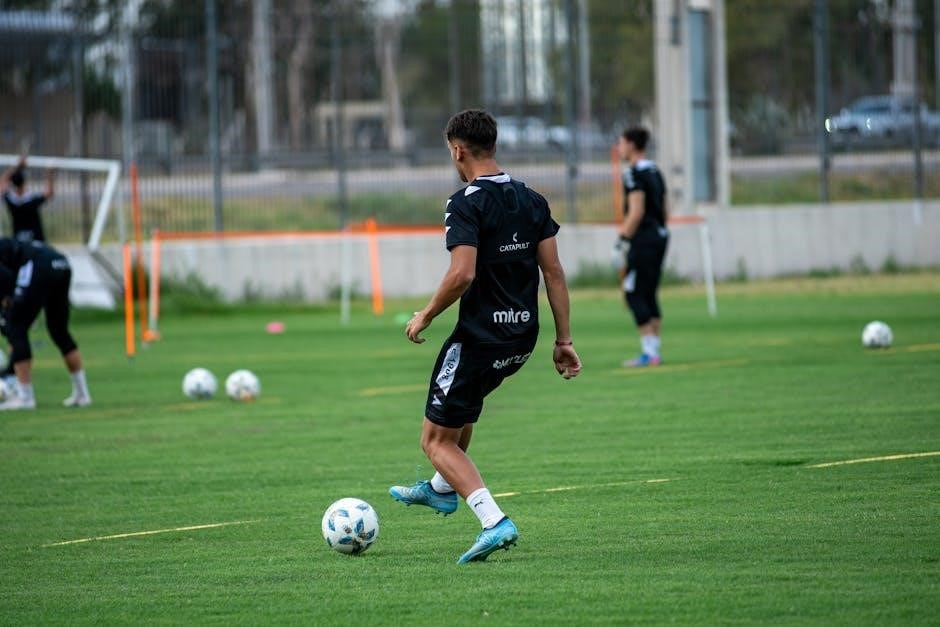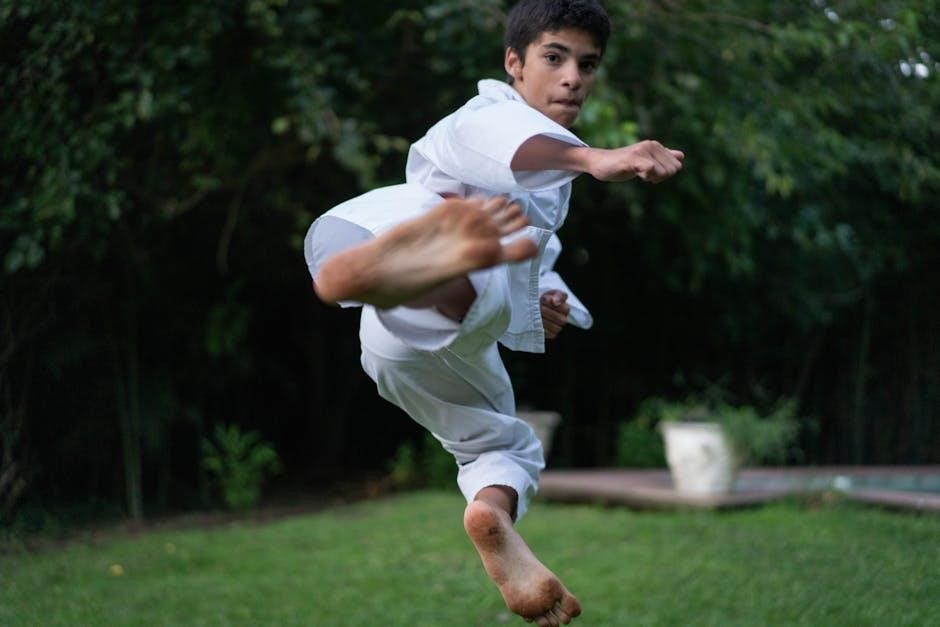Speed and agility are foundational skills for youth athletes, enhancing performance and reducing injury risk. Proper training improves coordination, balance, and overall athletic ability, essential for long-term success in sports.
Importance of Speed and Agility in Youth Athletics
Speed and agility are critical components for youth athletes, directly impacting performance across various sports. These skills enhance the ability to react quickly, change direction efficiently, and maintain balance during dynamic movements. Developing speed improves acceleration and sprinting capabilities, while agility fosters better coordination and decision-making on the field. Both traits not only boost athletic performance but also reduce injury risks by strengthening muscles and improving overall mobility. Moreover, these skills are transferable across sports, making them essential for versatile athletes. Incorporating speed and agility training early in a youth athlete’s development lays a strong foundation for future success, ensuring they can compete at higher levels with confidence and effectiveness.

Components of a Youth Speed and Agility Training Program

- Speed Training Fundamentals: Focuses on acceleration, sprinting, and proper running mechanics.
- Agility Drills: Includes cone drills, ladder exercises, and reaction training for quick changes of direction.
- Strength Development: Builds muscular power to enhance explosive movements and endurance.
- Plyometric Exercises: Improves jump height, speed, and overall power through dynamic movements.
- Resistance Band Work: Enhances flexibility, strength, and speed in a controlled, safe manner.
Speed Training Fundamentals
Speed training is the cornerstone of any youth athlete’s development, focusing on acceleration, maximum speed, and speed endurance. Proper running mechanics are emphasized to optimize efficiency and reduce injury risks. Drills such as sprints, hill runs, and resisted runs with resistance bands are commonly used. These exercises target the development of fast-twitch muscle fibers, essential for explosive movements. Coaches often incorporate techniques like high knees and butt kicks to improve stride rate and length. Additionally, plyometric exercises like jump squats and box jumps are integrated to enhance power and speed. Age-appropriate progression ensures that each athlete builds a strong foundation, preparing them for more advanced training as they mature.
Agility Training Basics
Agility training focuses on enhancing an athlete’s ability to change direction quickly, maintain balance, and react to stimuli. Cone drills, ladder exercises, and shuttle runs are fundamental exercises that improve coordination and nimbleness. These drills are designed to develop quick footwork, sharp cuts, and rapid deceleration. Incorporating small obstacles and reaction-based tasks helps simulate real-game scenarios, boosting decision-making under pressure. Progression begins with stationary exercises and gradually introduces movement and complexity. Emphasizing proper technique ensures safety and maximizes benefits. Agility training not only enhances physical skills but also mental alertness, preparing young athletes for the demands of competitive sports. Regular practice fosters confidence and adaptability, essential for excelling in dynamic environments.
Strength and Power Development
Strength and power development are critical components of a youth speed and agility training program. Building muscular strength through exercises like squats, lunges, and push-ups creates a foundation for explosive movements. Power, the ability to generate force quickly, is enhanced through plyometric exercises such as jump squats and box jumps. Resistance bands and medicine balls are also effective tools for improving strength and power. Age-appropriate weightlifting, such as Olympic lifts, can be introduced for older athletes to further develop these traits. Proper progression ensures safety and effectiveness, with a focus on technique and gradual overload. Strengthening muscles not only enhances athletic performance but also reduces the risk of injury, making it a vital part of youth training programs.

Training Methods for Youth Speed and Agility
Effective methods include plyometric exercises, resistance band runs, and small-sided games. These drills enhance acceleration, deceleration, and change-of-direction skills, improving overall athletic performance in young athletes.
Plyometric and Resistance Band Exercises
Plyometric exercises, such as jump squats and box jumps, improve explosive power and speed. Resistance bands enhance strength and acceleration, making them essential for youth training programs. These tools help develop foundational skills like speed and agility, crucial for athletic performance. By incorporating these exercises, young athletes can build the necessary power and endurance to excel in their sports. Proper form is emphasized to ensure safety and effectiveness, making plyometrics and resistance bands valuable additions to any training regimen.
Small-Sided Games and Sport-Specific Drills
Small-sided games and sport-specific drills simulate real-game scenarios, allowing youth athletes to apply speed and agility in context. These exercises enhance decision-making and reaction time while improving technical skills. Drills tailored to specific sports, such as shuttle runs for soccer or zig-zag drills for basketball, help athletes adapt movements to their sport’s demands. Small-sided games, like 3v3 or 4v4, reduce complexity and increase participation, fostering a competitive yet developmental environment. By integrating these drills, young athletes develop functional speed and agility that directly translate to improved performance on the field or court.
Progression and Safety in Youth Training
Progression and safety are critical in youth training, ensuring drills are age-appropriate and supervised to prevent injuries while promoting skill development and confidence.
Age-Appropriate Progression of Drills
Age-appropriate progression ensures drills match a child’s developmental stage, optimizing learning and reducing injury risks. Younger athletes focus on basic movements like sprints and changes of direction, while older athletes incorporate more complex agility drills. Coaches should assess skill mastery before advancing, allowing each child to progress at their own pace. This tailored approach fosters confidence and enhances athletic performance. Proper progression also ensures that training remains engaging and challenging, keeping young athletes motivated and eager to improve. By aligning drills with age-specific abilities, programs create a strong foundation for long-term athletic development.
Safety Guidelines and Injury Prevention
Safety is paramount in youth speed and agility training to prevent injuries and ensure a positive experience. Coaches should emphasize proper warm-ups, dynamic stretching, and cooldowns to prepare muscles and joints. Supervision is crucial to correct technique and prevent overexertion. Proper footwear and equipment, such as resistance bands, should be used to minimize risks. Teaching athletes to listen to their bodies and rest when needed helps avoid overtraining injuries. Creating a safe environment involves ensuring adequate space for drills and removing hazards. By prioritizing safety, coaches can help young athletes develop skills confidently while reducing the likelihood of injuries. This approach fosters a culture of responsibility and care, essential for long-term athletic development.

Measuring Success and Tracking Progress
Success in youth speed and agility training is measured through improved performance metrics like sprint speed, agility drills, and overall power. Regular assessments and tracking progress ensure growth and motivation.

Assessing Speed and Agility in Youth Athletes
Assessing speed and agility in youth athletes involves using standardized tests to measure performance. The 40-yard dash is a common speed test, while the Pro Agility Shuttle evaluates agility. These tests help track progress and identify areas for improvement. Coaches often use video analysis to assess technique and provide feedback. Regular assessments ensure training programs are effective and tailored to individual needs. Proper form and safety are prioritized during testing to avoid injuries. By monitoring improvements in speed and agility, coaches can adjust training plans to maximize results. Consistent evaluation helps youth athletes stay motivated and focused on their development goals. Accurate assessments are key to building a well-rounded athlete.
Long-Term Athlete Development (LTAD)
LTAD is a structured approach to developing young athletes over time, focusing on age-appropriate training. It emphasizes building speed, agility, strength, and skill in phases. Early stages focus on fundamental movements, while later stages refine sport-specific abilities. LTAD ensures athletes progress safely, reducing injury risks. It aligns with the natural growth and maturation process, optimizing performance potential. Coaches adapt training to suit each athlete’s developmental stage. This model promotes consistency and long-term success, fostering well-rounded athletes capable of excelling in various sports. By following LTAD principles, coaches and parents can support athletes in achieving their full potential. This approach is essential for sustainable growth in youth sports.
Additional Resources and Tools
Explore comprehensive guides, workout plans, and expert tutorials to enhance youth speed and agility training. Utilize drills, videos, and tools for effective program implementation and tracking progress.
Recommended Drills and Workout Plans
A well-structured youth speed and agility program should include a variety of drills tailored to age and skill level. Plyometric exercises, such as box jumps and burpees, enhance explosive power. Resistance band runs and lateral shuffles improve acceleration and quick changes of direction. Agility ladder drills are excellent for developing foot speed and coordination. Cone exercises, like zigzag runs and shuttle sprints, simulate sport-specific movements. Small-sided games, such as 3v3 soccer or flag football, combine agility with game-like scenarios. For a balanced workout, incorporate strength training with bodyweight exercises like squats and lunges. Progress drills gradually, ensuring proper form to prevent injuries and maximize effectiveness. Consistency and variety are key to building lasting speed and agility in young athletes.
